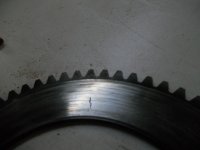Well I have my clutch out of the T3. The friction plates were soaked in oil, I have them sitting in a bath of lacquer thinner at the moment, will this resurrect the plates?
I also noticed that there is a small (stress) crack on the intermediate plate. Is this something I should be concerned about or should I slap it back in as is.
Thanks, Joël
I also noticed that there is a small (stress) crack on the intermediate plate. Is this something I should be concerned about or should I slap it back in as is.
Thanks, Joël

